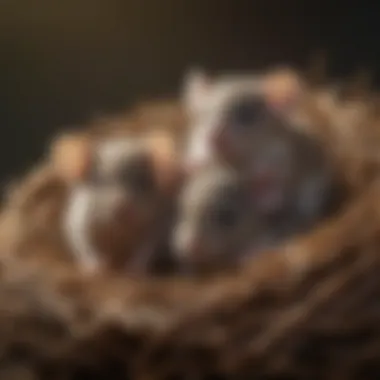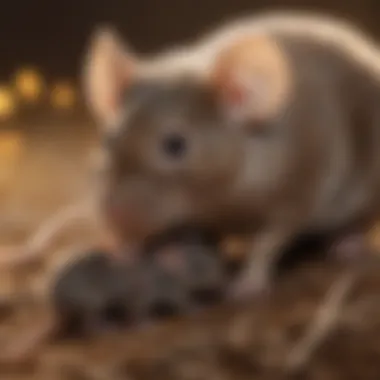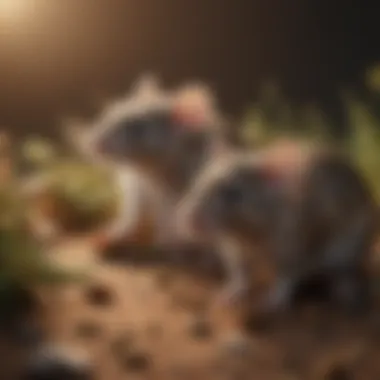Understanding Mice Litters: Behavior, Ecology, and Adaptability


Intro
Mice play a crucial role in ecosystems. Understanding their behavior and how they interact within their population is an important area of study. This understanding can help us manage wildlife more effectively and support conservation efforts.
This article navigates through the concept of a litter of mice. We will explore their reproductive habits, developmental stages, and ecological significance. Additionally, we will provide insights into their social structures and communication methods. Our goal is to present a comprehensive view that serves both veterinarians and wildlife biologists, while aiding families to appreciate the intricate lives of these small creatures.
Animal Overview Common Name and Scientific Classification
Mice belong to the family Muridae. The most common species, the house mouse, is scientifically classified as Mus musculus. This species is prevalent due to its adaptability to various environments and its close association with humans.
Physical Characteristics
House mice are small mammals. Their average length ranges from 7.5 to 10 cm, excluding the tail. The tail is nearly the same length as the body. They have smooth fur that can be gray, brown, or black. Their ears are large compared to their body and contribute to their keen sense of hearing.
Habitat and Distribution
Mice thrive in diverse habitats. They can be found in forests, grasslands, and urban settings. Their ability to adapt to human environments has led to widespread distribution across the globe. They are mostly nocturnal, seeking shelter in small crevices during the day.
Behavior and Social Structure Communication Methods
Mice communicate through various means. They use vocalizations, body language, and scent markings. Ultrasound calls are often used between mothers and their young. Scent marking helps establish territory and alert others to their presence.
Social Hierarchies
Mice exhibit social structures that can vary significantly. Groups may form around resources such as food or nesting sites. Within these groups, hierarchies develop, often determined by age or size. Understanding these dynamics can give insight into their behavior in the wild.
Mating and Reproductive Behavior
Mice are prolific breeders. A female can produce several litters in a year. Each litter may comprise five to eight pups. The mating rituals include chasing and grooming, which strengthens bonds between partners. Maternal care is critical in the early stages of life, as mother mice nurse their pups for up to three weeks.
Conservation Status Current Population Trends
House mice have stable population trends in many regions. They thrive in human-altered environments, which often leads to overpopulation issues. In some areas, this results in agricultural damage and conflicts with human interests.
Threats and Challenges
Despite their adaptability, mice face threats from habitat destruction and environmental changes. Predators such as owls and snakes also impact their populations. Moreover, the use of rodenticides in urban areas poses significant risks to mouse populations.
Conservation Efforts and Success Stories
Conservation programs aim to create balance in ecosystems where mice exist. Habitat restoration is one effort to support their populations. Successfully managing their role within ecosystems can yield positive results, including reduced crop damage and enhanced biodiversity.
Understanding the litter of mice is not only essential for population management but also for ecological health. This knowledge can lead to effective wildlife management strategies.
The study of mice is a gateway to understanding broader ecological interactions. By examining their behavior and social structures, we gain insights that can inform wildlife conservation efforts in a meaningful way.
Foreword to Mice
Understanding mice is crucial as they play various roles within ecosystems and have significant impacts on both wildlife and human contexts. Mice are not just common rodents; they exhibit complex behaviors, social structures, and ecological interactions. Exploring the introductory concepts provides a solid foundation for comprehending more specific aspects as the article progresses. Topics such as their reproductive behaviors and ecological impacts will reveal their adaptability and importance. Recognizing the multifaceted nature of mice highlights the need for detailed study in fields such as veterinary science, wildlife biology, and even in family settings where understanding these creatures can lead to better coexistence.
Overview of Mouse Species
Mice belong to the family Muridae, encompassing numerous species, with Mus musculus being the most recognized. This particular species is prevalent in varied environments and has adapted exceptionally well to urban settings. Other species, like the deer mouse (Peromyscus maniculatus) and the field mouse (Apodemus sylvaticus), also have distinguished traits that suit them to their respective habitats.
The diversity among mouse species contributes to their ecological roles. Each species has evolved specific adaptations, be it through their foraging strategies, reproductive patterns, or social behaviors. For instance, the house mouse is known for its capacity to thrive in human environments, using scraps and food stores left by us.
Some common mouse species include:
- House Mouse (Mus musculus): Highly adaptable; found often around humans.
- Deer Mouse (Peromyscus maniculatus): Prefers wooded areas; known for its agility.
- Field Mouse (Apodemus sylvaticus): Generally found in fields and heath.
- Harvest Mouse (Micromys minutus): Excellent climber; lives in vegetation.


Understanding these species and their characteristics helps in wildlife management and results in better conservation efforts.
Significance of Mice in Ecosystems
Mice play integral roles within their ecosystems. They serve as prey for various predators like owls, snakes, and foxes. This positioning in the food chain highlights their importance in ecological balance. Additionally, mice contribute to seed dispersal or the control of plant populations through their foraging habits. This role directly affects plant diversity and habitat structure.
Mice also impact soil dynamics. Through their burrowing activity, they aerate the soil, which enhances plant growth and decreases erosion. Their foraging leads to nutrient cycling, further enriching the ecosystem.
Mice are often seen as indicators of environmental health. Changes in their populations can reflect alterations in ecosystem dynamics, pointing to broader environmental issues.
This understanding aids scientists and wildlife biologists in developing strategies that consider not only conservation needs but also human impacts on these vital creatures. Through the lens of ecological importance, mice emerge as more than simple rodents; they are critical players in sustaining the health and balance of their habitats.
Reproductive Behavior
Reproductive behavior in mice is fundamental to their survival and ecological niche. Understanding these patterns provides insights into population dynamics, resource distribution, and overall community health. The reproductive success of a species directly influences ecological balance and the availability of mice as prey for various predators. In this section, we will explore mating patterns and the dynamics of gestation and litter sizes, both of which have vital implications for mouse ecology.
Mating Patterns in Mice
Mice exhibit complex mating behaviors characterized by various patterns such as promiscuity and mate guarding. Female mice usually become sexually mature at about six weeks old, which allows for rapid population growth. Males, on the other hand, can also reach sexual maturity at a similar age, complicating the mating dynamics.
Courtship rituals among mice are intricate. Males often engage in vocalizations, pheromonal signaling, and physical displays to attract females. This behavior helps ensure genetic diversity within populations. Mice are known to form temporary pair bonds during mating periods, but these bonds do not typically last long.
Factors such as environmental conditions and population density can influence mating behavior. High population density may lead to increased competition among males, resulting in more aggressive courtship strategies. Understanding these mating patterns is essential for wildlife management initiatives, as they help gauge potential population spikes or declines, which can impact ecosystem health.
Gestation Period and Litter Size
The gestation period for mice is relatively short, averaging around 19 to 21 days. This quick turnaround is advantageous in terms of reproductive success. After gestation, the female typically gives birth to a litter consisting of multiple pups. Litter sizes can vary greatly, ranging from two to fourteen pups, depending on several factors including the species of mouse and environmental conditions.
The female's care for her young is crucial in their early stages. She nurses the pups for about 3 weeks, during which the pups grow rapidly and start to develop key survival skills. After weaning, they begin to explore their surroundings, establishing independence by around four weeks of age.
Litter sizes and the success of rearing depend heavily on resource availability. In environments with abundant food and shelter, mice tend to have larger litters. In contrast, competition for resources can lead to smaller litters and higher mortality rates among young mice. This adaptive behavior allows mouse populations to thrive in varying ecological conditions while also providing essential prey for numerous predators.
Understanding reproductive behavior in mice can aid conservation efforts. The ability to quickly adapt their reproductive strategies is key for their survival amidst changing environmental conditions.
Lifecycle of Mice
The lifecycle of mice is critical in understanding their behavior and ecological role. It offers insight into the various stages these animals pass through, from birth to maturity. Recognizing these stages provides plenty of benefits. We can see patterns in their behavior, reproductive strategies, and strategies for survival. These elements are vital for wildlife management, conservation efforts, and fostering a deeper comprehension of ecological interactions.
Stages of Development
Neonate Stage
The neonate stage lasts from birth to about two weeks of age. At this stage, mice are extremely vulnerable. They are born hairless, blind, and entirely dependent on their mother for nourishment and warmth. This dependence is a key characteristic of the neonate stage.
Value for Study: Understanding the challenges that newborn mice face is important for wildlife biologists. It highlights the significance of parental care and environmental factors on survival rates.
Unique Feature: Neonates rely heavily on their mother to fulfill all needs. This dependency means that any external stress on the mother can result in decreased survival for the young.
Advantages/Disadvantages: The vulnerability of neonates shows the need for a safe nesting environment. However, this also drives adaptation strategies within the species. The risks during the neonate stage emphasize the necessity of understanding breeding and caring methods in captive settings.
Juvenile Stage
The juvenile stage occurs from about three weeks to six weeks. In this phase, mice begin to explore their surroundings, marking a significant shift in their development.
Value for Study: Studying juvenile behavior can inform on territory establishment and conflict resolution among mice. It shows why specific social structures develop.
Key Characteristic: Juveniles start to mimic adult behaviors and begin to establish their independence. They are more mobile and start to forage for food, although they may still rely on the parental figures.
Unique Feature: Their curiosity makes them prone to exploration but also exposes them to various dangers. Understanding these dynamics can contribute to better habitat management.


Advantages/Disadvantages: While this developmental stage fosters independence, young mice may not yet have the skills to properly forage, making them vulnerable to predation.
Adult Stage
The adult stage starts at about six weeks of age. Mice are now fully mature and capable of reproduction. Behavior and social interactions become well-defined during this stage.
Value for Study: The adult stage is crucial for evaluating population dynamics. It aids in understanding how environmental factors influence breeding and survival.
Key Characteristic: Adult mice demonstrate clear hierarchical structures, which are vital for social interactions. They can defend territories and establish dominance.
Unique Feature: Adult mice possess skills for foraging and building nests that they will carry throughout their lifespan. These skills are crucial for successfully raising litters.
Advantages/Disadvantages: Adults can reproduce, contributing to population growth. However, increased competition can arise, affecting the species' overall dynamics.
Parental Care and Nesting Behavior
Parental care significantly influences the survival and success of mouse litters. Mother mice show intense care, ensuring that neonates are fed and protected. This nurturing behavior is essential for the initial survival of the young.
Building nests is another aspect of parental behavior. Mice often choose locations that provide safety and warmth. This choice directly impacts the health of the young mice. Environmental factors surrounding nesting sites can also affect the development of litters. An understanding of how these behaviors interconnect offers critical insights into mouse population dynamics and resilience.
The lifecycle of mice reveals complex interactions between various stages of development and environmental factors, showcasing their adaptability.
Social Structure and Behavior
Understanding the social structure and behavior of mice reveals significant aspects of their lives. This knowledge provides insights into how these animals interact, establish their territories, and communicate. These factors are crucial for researchers, veterinarians, and wildlife biologists in their work surrounding mouse populations. The ability to comprehend their social dynamics improves wildlife management and conservation efforts, which benefits both the species and the broader ecosystem.
Hierarchy and Territory
Hierarchy in mouse communities can be quite complex. Mice create a social structure that includes dominant and subordinate individuals. This hierarchy affects access to resources such as food and nesting sites. Dominant mice, often larger or more aggressive, may secure prime locations and resources, while subordinates are left with less favorable positions.
- Territorial behavior: Mice are typically territorial, especially males. They mark their territory with urine scent to warn off intruders. This behavior reduces conflicts among members of the same species. It also helps in maintaining a stable population density.
- Social grouping: Mice often live in groups called colonies. These units can vary in size and composition. While some species cooperate closely within their groups, others may show solitary behaviors. The social interactions within these groups are vital for survival, particularly in shared foraging and predator detection.
Research has shown that understanding hierarchical structures can aid in better management practices for mice in both wild and controlled environments. Familiarity with their social behavior patterns allows for informed decisions in habitats where they coexist with humans.
Communication Among Mice
Mice utilize an array of communication methods that can be both vocal and non-vocal. Understanding these methods is essential for grasping how they interact and respond to their environment.
- Vocalizations: Mice emit various sounds, including squeaks and chirps, which convey different messages. These vocalizations can indicate distress, mating calls, or signaling to others about food sources.
- Scent marking: As mentioned earlier, scent marking is crucial for territory establishment. Pheromones play a vital role in communication as well. They help mice identify each other and detect reproductive status, potentially influencing mating behaviors.
- Body language: Mouse interactions often include physical gestures, such as grooming and tail positioning. These actions can show dominance or submission within the hierarchical structure. Awareness of these forms of communication contributes to a deeper understanding of mouse behavior.
“The social and communicative nuances among mice reveal their adaptive strategies for survival and successful coexistence.”
Ecological Importance of Mice
Mice play a pivotal role in various ecosystems, contributing to the balance of environments where they thrive. Their small size and rapid reproduction rates enable them to occupy a niche in the food web that impacts numerous species. Understanding their ecological importance is essential for wildlife management and fostering healthy ecosystems.
Diet and Foraging Behavior
Mice are primarily omnivorous, consuming a variety of foods that reflect their adaptive strategies. This flexibility in diet allows them to exploit different resources available in their habitats. Common food items include grains, seeds, fruits, and even small insects.
- Foraging Strategies: Mice often forage alone or in small groups, using their keen senses to locate food. They tend to be crepuscular, being most active during dawn and dusk. This behavior reduces competition and increases their odds of avoiding predators.
- Impact on Seed Dispersal: As they consume seeds and fruits, mice play a significant role in seed dispersal. Their foraging habits help in the propagation of plants, creating a dynamic relationship between flora and fauna.
This relationship emphasizes the importance of diet diversity in maintaining ecological balance.
Role in Food Chains
Mice are a crucial link in food chains, functioning as prey for a variety of predators including birds of prey, snakes, and larger mammals. Their population dynamics can influence the abundance and health of predator species.
- Predator-Prey Dynamics: The survival of many predators relies on the availability of mice. When populations of mice fluctuate, it directly affects the populations of their predators. This interdependent relationship showcases how the health of ecosystems can hinge on mouse populations.
- Nutrient Cycling: Mice contribute to nutrient cycling as they break down plant materials and other organic matter. Their activities return essential nutrients to the soil, which in turn promotes plant growth. This nutrient cycling is fundamental for maintaining the productivity of ecosystems.


In summary, examining the ecological importance of mice reveals their critical roles in food webs and ecosystem dynamics. Their behavior and dietary habits are closely intertwined with their environmental contexts, which calls for thoughtful considerations in wildlife management and conservation efforts.
Mice in Human Contexts
Mice have a complex relationship with humans, influencing diverse facets of societal functioning. Understanding how these animals interact with human contexts is crucial. It elucidates their significance in various domains such as companionship, research, and ecological management. This discussion explores the benefits and considerations regarding the domestication of mice and their use as laboratory subjects.
Domestication and Training
Domestication of mice dates back thousands of years. Initially, their role as part of the human environment was primarily utilitarian, aiding in pest control and acting as a food source for larger predators. Nowadays, many individuals keep mice as pets due to their charming personalities and manageable size. They can be trained to perform simple tricks, which enriches both their lives and those of their owners.
Benefits of Domestication
- Companionship: Mice offer emotional support to many, acting as small confidants. They can be quite affectionate.
- Educational value: Keeping mice can teach children about responsibility, empathy, and biology.
- Research potentials: Domesticated mice have various applications in behavioral studies.
While domestication brings numerous benefits, one must consider ethical aspects of care. Proper habitats, social interaction, and health management are essential for their well-being.
Mice as Laboratory Subjects
Mice serve as valuable models in scientific research. Their genetic, biological, and behavioral similarities to humans make them ideal subjects for various studies, especially in genetics, psychology, and physiology. Research using mice has contributed significantly to advances in medicine and understanding human diseases.
Why Use Mice in Research?
- Short lifecycle: Mice reproduce quickly, allowing researchers to study multiple generations in a short time.
- Genetic manipulation: Their genomes can be easily modified, offering insights into genetic diseases.
- Behavioral studies: Mice are social creatures, making them suitable for studying social interactions and learning.
While mice provide significant advantages in research, ethical considerations are paramount. Adhering to guidelines for humane treatment and minimizing suffering is important in any research context.
The utility of mice in human contexts reflects their adaptability and significance in various dimensions of life, from personal companionship to scientific advancement.
Through understanding the interplay between mice and humans, one appreciates the broader implications for wildlife management and conservation efforts. Continued exploration in these areas can contribute to more ethical practices and informed public awareness.
Conservation and Ethical Considerations
Conservation and ethical considerations surrounding mice populations hold significant relevance within the context of this article. As we explore facets such as habitat preservation and the methodologies employed in mouse research, a nuanced understanding of these elements proves vital. Mice, as key species in many ecosystems, are often subject to habitat loss due to urban development, agriculture, and climate change. Acknowledging their ecological roles and advocating for conservation strategies is essential in mitigating the negative effects of such losses.
Impact of Habitat Loss on Mouse Populations
Habitat loss is a critical concern for mouse populations across various environments. Urbanization often leads to fragmentation of habitats, isolating mouse colonies and affecting their genetic diversity. Loss of natural resources can diminish their shelters and food sources, making survival increasingly difficult.
- Fragmentation Effects: Small populations become vulnerable to extinction due to lack of genetic diversity. This can lead to inbreeding, making them less adaptable to environmental changes.
- Resource Scarcity: Reduction in food and nesting opportunities forces mice to compete more aggressively. This could lead to increased aggression among species and changes in social structures.
- Altered Behavior: Habitats are often lost to agricultural practices, which can lead to behavioral changes in mice. For example, the need to forage longer distances can impact their reproductive success.
Understanding these dynamics is crucial for wildlife management and conservation policies, ensuring that sufficient habitats remain intact for mouse populations to thrive.
Ethics of Mouse Research and Care
The ethical considerations surrounding mouse research and care are paramount, particularly in laboratory settings. Research involving mice often raises questions regarding welfare, treatment, and the purpose of such studies. There are several aspects to consider when discussing these ethical implications:
- Humane Treatment: Standards must be established for the care of mice in laboratories. This includes ensuring that their living conditions mimic natural habitats as much as possible.
- Purpose of Research: Ethical frameworks must guide research practices. Studies should aim at advancing scientific knowledge while minimizing harm to the subjects involved.
- Transparency: Research findings and methodologies should be openly shared, allowing for peer evaluation and public scrutiny. This builds trust in scientific communities and informs ethical standards.
Epilogue and Future Directions
Understanding the behaviors and ecological roles of mice, especially through the lens of their litter, offers multiple important insights. This article has navigated through various areas including reproductive patterns, developmental stages, and the ecological importance of mice. In pondering the future directions of this research, several critical considerations arise.
Implications for Wildlife Management
Effective wildlife management is paramount for sustaining various ecosystems. Mice play significant roles as both prey and competitors in their environments. As such, understanding their litter dynamics can inform practices in population control and habitat conservation. For instance, knowledge of litter sizes and reproductive cycles allows wildlife managers to predict population booms or declines, enabling timely interventions. Also, by emphasizing their roles as seed dispersers and consumers of organic matter, we can create strategies that enhance biodiversity while maintaining the balance in natural habitats. Practical applications derived from understanding mouse behaviors can lead to better conservation techniques.
Future Research Avenues
Several pathways present opportunities for advancement in the study of mice and their litters. Research could focus on the impact of environmental changes on litter size and survival rates. Specific areas of interest might include:
- Effects of climate change on reproductive behaviors.
- Influence of urbanization on nesting and social structures.
- Comparative studies between domestic and wild mouse populations to understand behavioral adaptations.
Additionally, interdisciplinary approaches, combining genetics, ecology, and behavior studies, could yield richer insights into the adaptability of mice. Such research is critical to address ongoing challenges in wildlife management and conservation efforts. As our understanding evolves, so too must our methods in promoting ecological balance and delivering responsible stewardship of natural resources.
"The intricacies of mouse behavior serve as a microcosm of broader ecological systems, providing essential lessons on adaptation and coexistence."
In closing, this exploration underscores the relevance of studying mice not only as individual species but as integral components within complex ecosystems. Future research holds promise for more sustainable management practices and deeper ecological understanding.







